- Home
- TV History
- Network Studios History
- Cameras
- Archives
- Viewseum
- About / Comments
Skip to content
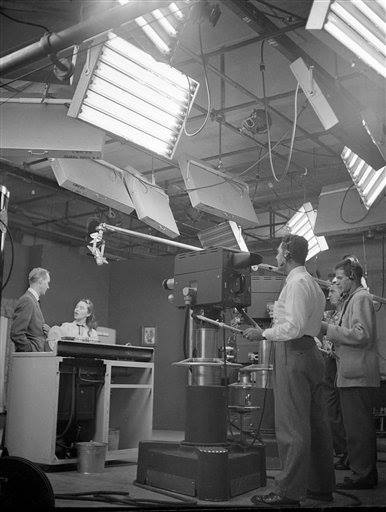

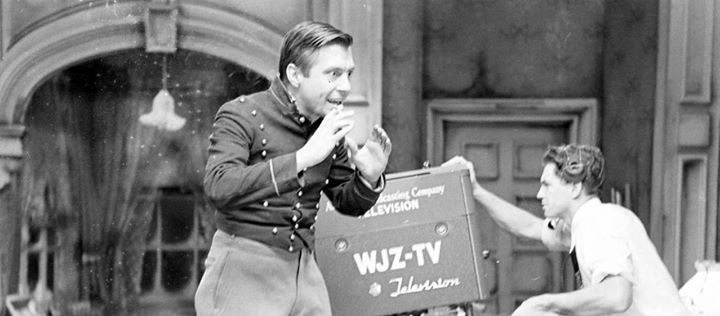



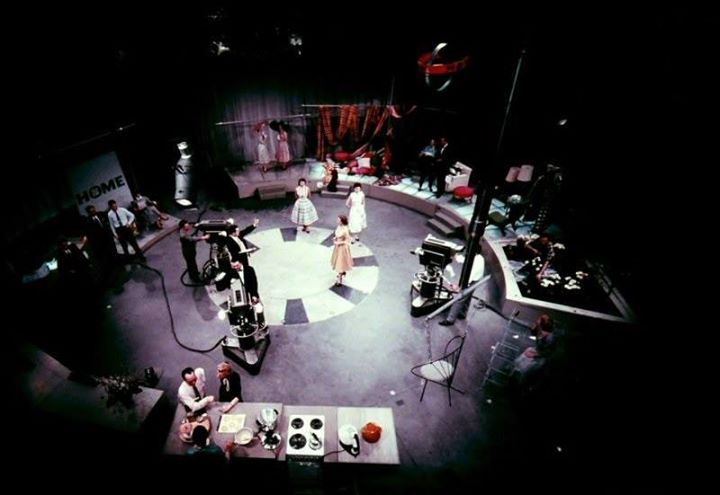



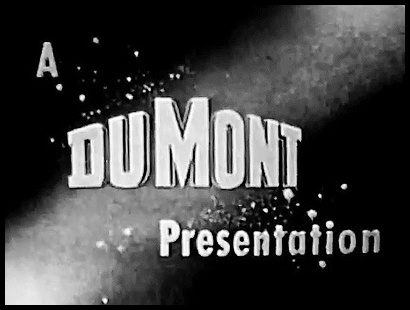







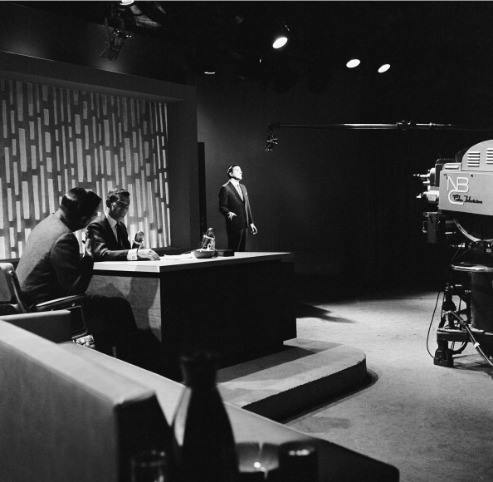

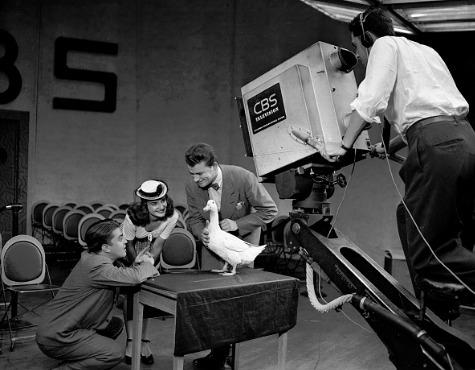

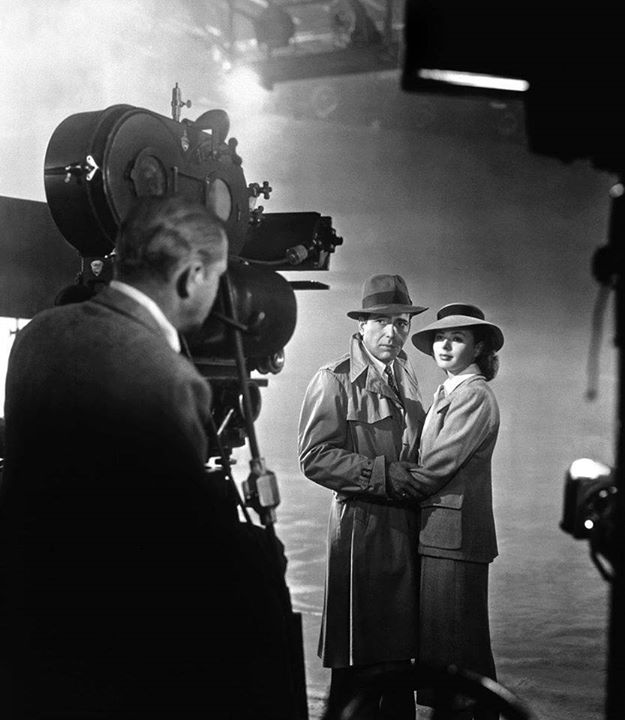

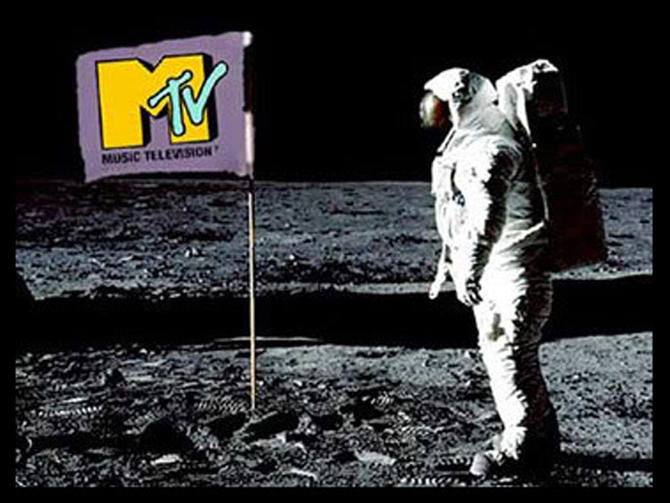

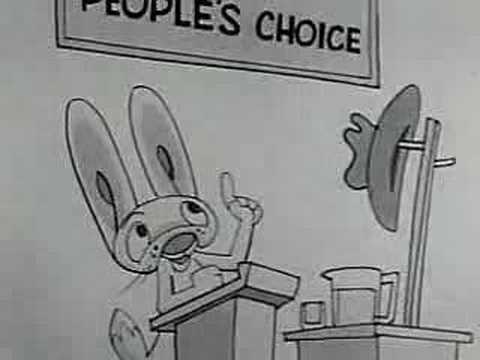



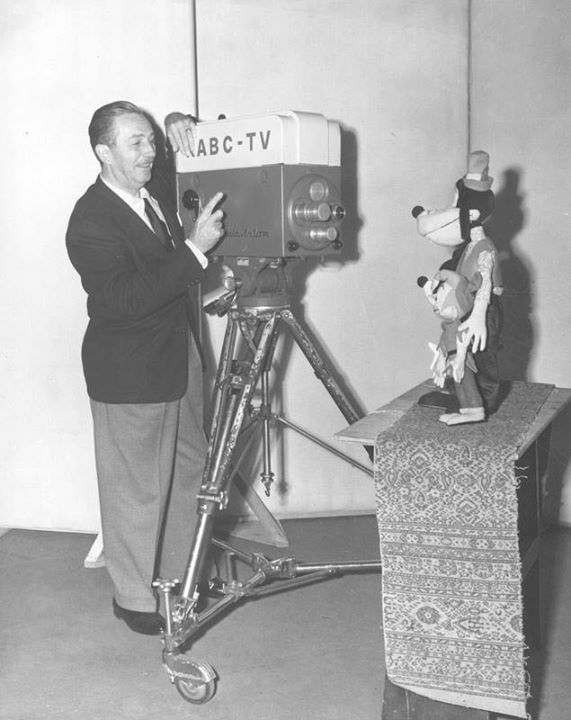

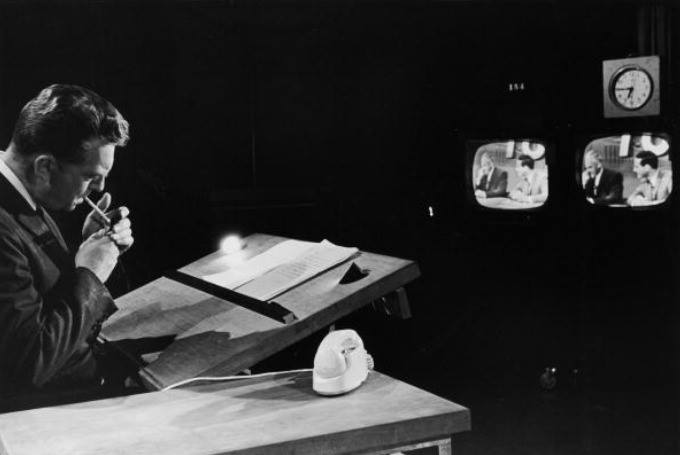


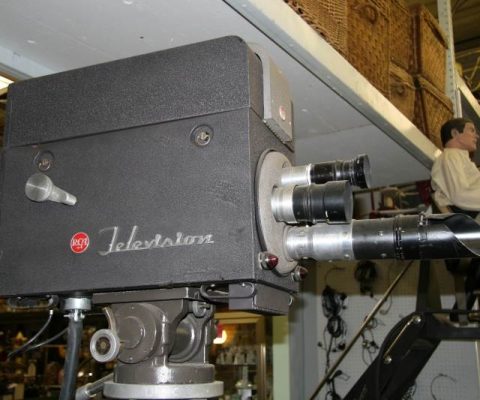


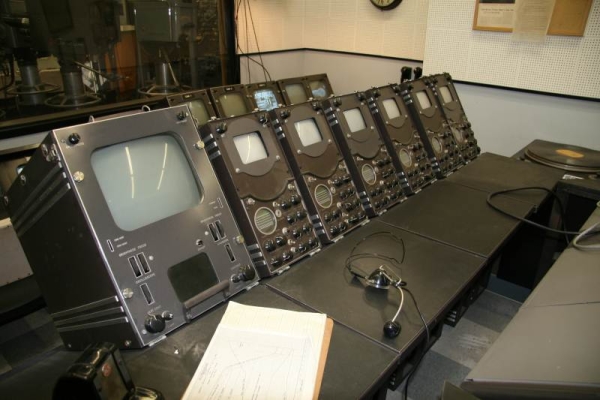






Posts in Category: TV History
Page 19 of 136
« Previous
1
2
3
4
5
6
7
8
9
10
11
12
13
14
15
16
17
18
19
20
21
22
23
24
25
26
27
28
29
30
31
32
33
34
35
36
37
38
39
40
41
42
43
44
45
46
47
48
49
50
51
52
53
54
55
56
57
58
59
60
61
62
63
64
65
66
67
68
69
70
71
72
73
74
75
76
77
78
79
80
81
82
83
84
85
86
87
88
89
90
91
92
93
94
95
96
97
98
99
100
101
102
103
104
105
106
107
108
109
110
111
112
113
114
115
116
117
118
119
120
121
122
123
124
125
126
127
128
129
130
131
132
133
134
135
136
Next » August 11, 2009…72 Year Run Of “The Guiding Light” Ends
On August 11, 2016
- TV History
August 11, 2009…72 Year Run Of “The Guiding Light” Ends
The Guiding Light is credited by the Guinness Book of World Records as the longest running drama in television history, running from 1952 until 2009, preceded by a 15-year broadcast on the radio.
First broadcast five days after President Franklin D. Roosevelt’s second inauguration, the title “The Guiding Light”, refers to a lamp in the study of Reverend Dr. John Ruthledge (a major character when the show debuted) that family and residents could see as a sign for them to find help when needed.
June 30, 1952 is the day “The Guiding Light” came to television. It’s first TV home was in CBS Studio 56 at Liederkranz Hall on East 58th street, where two of the four studios there had Dumont cameras. After the consolidation of production into the CBS Broadcast Center and colorizing in the mid 60s, Liederkrantz was closed, but ‘TGL’ was a big show so CBS moved it to a facility of it’s own…Studio 65, The High Brown Theater on 26th Street, which had upstairs and downstairs studio floors.
The black and white photo is from September of ’52 in Studio 56. The two color photos are from Studio 65. The studio shot was taken in the basement, while the control room and bigger studio were on the first floor. Occasionally, actors would have to race from one floor to the other to make appearances in the same scene.
‘The Guiding Light’ was created by Irma Phillips, and began as an NBC Radio serial on January 25, 1937. On June 2, 1947, the series was moved to CBS Radio. Even after it’s television debut, the show would continue to be broadcast concomitantly on radio until June 29, 1956.
The series was expanded from 15 minutes to a half-hour in early 1968, which is probably when the move from 56 to 65 occurred. The show expanded to a full hour on November 7, 1977.
The series broadcast its 15,000th televised episode on September 6, 2006.On April 1, 2009, it was announced that CBS had cancelled the show due to low ratings.
The show taped its final scenes for CBS on August 11, 2009, and its final episode on the network aired on September 18, 2009. On October 5, 2009, CBS replaced “TGL” with an hour-long revival of “Let’s Make a Deal”, hosted by Wayne Brady.
With a 72 year run, TGL stands as the fourth longest-running program in all of broadcast history.
At the link is a full 15 minute episode from March 4, 1953 when the show as just 9 months old. The Duz commercial is live, and the pitch man is the show’s announcer Hal Simms. The Ivory commercial appears to be on film. Thanks to Gady Reinhold for the color photos. Enjoy and share! -Bobby Ellerbee


August 10, 1948…WJZ-TV (WABC) Signs On In New York
On August 10, 2016
- TV History
August 10, 1948…WJZ-TV (WABC) Signs On In New York
New York’s Channel 7 came to life 68 years ago today, so Happy Birthday! Below are articles from “Billboard” and “Broadcasting” that describe the gala night.
Since a lot of us are a bit rusty on ABC television’s owned & operated roots, here’s a short primer.
On April 19, 1948, the ABC Television Network began its broadcasts on its first primary affiliate, WFIL-TV in Philadelphia. Only the month before, ABC bought the Duland Riding Academy at 7 West 66 Street at their network’s new home, which would allow them to leave the space at 30 Rock, that they inherited in the NBC Blue Network deal.
In that it would be four months until WJZ came to the air in NYC,
some of those first ABC shows were shown on Dumont’s WABD. Finally, August 10, 1948, the network’s flagship owned-and-operated station, WJZ-TV in New York City, began its broadcasts. ABC’s other owned-and-operated stations launched over the course of the next 13 months.
WENR-TV in Chicago launched on September 17, 1948, while WXYZ-TV in Detroit went on the air October 9, 1948. KGO-TV in San Francisco went on the air May 5, 1949.
On May 7, 1949, Billboard revealed that ABC would spend $2.5 million to convert the old Vitagraph/Warner East Annex in Hollywood into The Prospect Studios, and construct a transmitter on Mount Wilson in anticipation of the launch of KECA-TV, which went on the air on September 16, 1949. The rest as they say, is history. Enjoy and share! -Bobby Ellerbee
August 9, 1936…Jesse Owens Won His 4th Gold Medal In Berlin
On August 9, 2016
- TV History
August 9, 1936…Jesse Owens Won His 4th Gold Medal In Berlin
The first live television coverage of a sports event in world history occurred during the 1936 Summer Olympics in Berlin, Germany. These games were televised by two German firms, Telefunken and Fernseh.
Telefunken’s two large stationary cameras were based on RCA technology and the single, smaller Fernseh “roving” camera was based on Philo Farnsworth’s system.
Above, the dark camera is the Fernseh camera and was a bit smaller than the big white Telefunken cameras. Both systems broadcast at 180 lines and 25 frames per second. Four different areas were telecast using three cameras. In total, 72 hours of live transmission went over the airwaves to special viewing booths, called “Public Television Offices” in Berlin and Potsdam.
The cameraman looking into the viewfinder on the Telefunken is Walter Bruch who later went on to develop the Phase Alternation Line System, or PAL that, was initially adopted by more than thirty countries and eventually, more than one hundred. When interviewed by German talk show host Hans Rosenthal on why he had named it the “PAL system”, Bruch replied that certainly no German would want to have a “Bruch-System” because Bruch in German is synonymous with “broken”.
By the way, the Telefunkens appear to have zoom lenses, but they’re not. There were several fixed focal length lens options that could be changed out (a 2 man job), and we can see an example of that in the telephoto lens shot. They have placed the focus mechanism on the outside of the camera instead of inside, and are already using cradle heads instead of friction heads. Enjoy and share! -Bobby Ellerbee
August 9, 1957…”Home” With Arlene Francis Ends Three Year Run
On August 9, 2016
- TV History
August 9, 1957…”Home” With Arlene Francis Ends Three Year Run
NBC’s “Home” show debuted March 1, 1954 at 11 AM from their 67th Street Studios which were built just a few years earlier by WOR.
The concept came from a show NBC President Pat Weaver had originally titled “Shopping”, and was designed for the upscale female demo. Weaver’s other creations “Today” and “Tonight” are alive and well, but “Home”, the third of the triad, ended with the 893rd and final episode on August 9, 1957.
When Arlene Francis was chosen as the host, Weaver changed the name to “Home” and broadened the scope of the show to add more entertainment and interviews, but each show did have a twelve minute segment on shopping and new products that ranged from food and furniture to clothes and cosmetics.
Instead of trying to present the show on a household type set, NBC spent $200,000 on a circular set that made it clear to viewers that it was done on in a modern television studio. As you can see it was shot “in the round”, but the set also rotated on a huge turntable and was one of the most versatile sets ever. There is also something special about the cameras, that I will point out on the individual photos, so click on those.
As you can see,NBC even built a huge ceiling mounted, remote control camera boom for overhead shots. What you can’t see it the elaborate plumbing the set had. As in the image with the girls with umbrellas, there were often special effects on the set, including a way to make and drain “rain”, as well as operate the kitchen sinks.
In the third year of the show, it was moved to the 10 o’clock hour as CBS was doing their best to counter program with Lucy reruns at 11. Although critics loved the show, it’s aim at the upper class female demo was too narrow and the ratings continued to drop forcing NBC to cancel it. Still under contract for another year, NBC replaced “Home” with “The Arlene Francis Show”, which was much livelier and had more entertainment. – Bobby Ellerbee


August 8, 1974…Nixon Jokes With Crew Minutes Before Resigning
On August 8, 2016
- TV History
August 8, 1974…Nixon Jokes With Crew Minutes Before Resigning
Forty two years ago, President Nixon announced his resignation to the nation from the Oval Office of The White House. The first seven minutes of this video capture his pre broadcast remarks which, under the circumstances, are truly remarkable, and a bit disturbing.
The CBS crews handled the pool coverage that night with two Norelco PC70s. Sensing a historic moment, a smart network tape operator started recording even before Nixon entered the office. As you will see, a lot of his very odd personality is revealed here.
Although it is not shown, after the speech, he turned to the crew and wished them a Merry Christmas…in August. Well, it was Nixon, after-all.
At the 7 minute mark, his resignation speech starts and the whole thing is here. To bad he didn’t do this a year earlier. Enjoy and share. -Bobby Ellerbee
Moments before he goes on-air to resign as President of the United States, Richard Nixon is calm and collected, joking with staff as they set up the pool fee…


August 6, 1956…The DuMont Network Goes Dark
On August 6, 2016
- TV History
August 6, 1956…The DuMont Network Goes Dark
In furthering television on a technical basis, DuMont brought a lot to the game, but financially, it had always been an uphill battle. Their deal with Paramount was always a problem, and without radio properties, they had no leverage with AT&T. At the link is the story of the final years. http://www.dumontnetwork.com/7.html
In a nutshell, here is how DuMont began to dismantle its network operations. On April 1, 1955, many of the entertainment programs on the network (including “Captain Video”, DuMont’s longest-running show) were dropped. Bishop Fulton J. Sheen’s last program aired a few weeks later, on April 26 (he would soon move to ABC).
By May, only eight shows remained on the DuMont network, and the AT&T coaxial-cable interconnection to DuMont affiliates in other cities was cancelled. Inexpensive programs like “It’s Alec Templeton Time” sustained what was left of the network during the summer months. A panel show called “What’s the Story” was the last regularly scheduled non-sports program on DuMont, with its final airing on September 23, 1955.
After that date, DuMont reserved its “live” network feed for occasional sporting events. The last program of any kind on the DuMont Television Network was “Boxing from St. Nicholas Arena”, with Chris Schenkel on August 6, 1956, although this show continued locally on WABD in New York City. -Bobby Ellerbee


August 5, 1957…”American Bandstand” Debuts On ABC
On August 5, 2016
- TV History
On this date in 1957, American Bandstand debuted on the ABC Television Network. Many tell of Dick Clark going to ABC with the show, but…according to Leonard Goldenson, it didn’t happen that way. Mr. Goldenson is the titan that built the network into the one we know today, and this narrative is based on his book, “Beating The Odds”.
In a nutshell, Goldenson’s friend and ABC’s top researcher, Ollie Treyz was responsible for bringing the show to the network. With an insatiable appetite for information, Ollie was reading the Philadelphia rating books and noticed a WFIL show called “Bandstand” had a consistent 15 or 16 rating, which was huge. Treyz was curious and called the man who had brought him to ABC in 1948…that was Roger Clipp who now managed ABC affiliate WFIL for Walter Annenberg.
Clipp sent a kinescope to Treyz, who showed it to his teenage daughter and her friends, who loved it. Treyz played it cool and told Clipp that although they didn’t think it would work, they would like to try it out on the network. They made a deal for $1500 per week for WFIL to produce the show, and Clark got a few spots a week for himself to sell. ABC sold the national spots for $1500 per minute.
At the time, ABC had a fairly competitive prime time, but not much more, which made it hard for them to gain new affiliates. Their afternoons were mostly soap operas and some game shows, but nothing special, with “Afternoon Film Festival” airing daily from 3-5. In the fall of 1955, ratings got a boost with the addition of the “Mickey Mouse Club”. It debuted as a one hour daily show that aired from 5-6. After the first 13 weeks, the MMC went to the half hour format and ran from 5-5:30 from then on.
ABC needed a game changer, and that’s what they got! It only took a few weeks for word to spread, and by Thanksgiving, “American Bandstand” was a hit! In the beginning, the local show, was 2 hours, but when it went to ABC it went to 90 minutes and then 60. In the summer of ’57, when it debuted, ABC ran the show from 3:30-5, and it was followed by “The Mickey Mouse Club” from 5-5:30.
13 weeks later, ABC decided to take advantage of thier new audience, and sandwiched the Johnny Carson hosted “Do You Trust Your Wife” into AB, with AB starting at 3 and DYTYW inserted from 3:30-4, followed by another hour of AB from 4-5. From 5-5:30, ABC rotated daily, “The Buccaneers”, “Adventures of Sir Lancelot”, “Superman”, “Woody Woodpecker” and “The Adventures of Wild Bill Hickok”, followed by “The Mickey Mouse Club” from 5:30 -6.
Of course, all these times are Eastern, which begs the question, how did they handle the west coast feed? Well, fortunately, by this time, ABC had a few of the new Ampex VR 1000 video tape machines in operation. The machines debuted in April of ’56, but it took a while to put them into production and get them delivered, and the networks got the first ones. I think CBS and NBC got 6, and ABC got 4 in the spring/summer of ’57.
Just two years earlier, the Dumont Network had gone dark making ABC the new third network, but NBC and CBS were light years ahead in programs and schedules. Bandstand and Mickey Mouse helped bridge some of that gap. The show ran for 30 years on ABC, first on weekday afternoons and later, on weekends. I would rate it a 10, how about you? Got a favorite Bandstand moment? Enjoy and share! -Bobby Ellerbee
Ultra Rare New Photo…The Very First Color Mobile Unit
On August 4, 2016
- TV History
Ultra Rare New Photo…The Very First Color Mobile Unit
This is the first, and only photo of the first color unit I have ever seen. Not much is known about this first RCA/NBC color mobile unit, but this rare new photo helps a lot in fleshing out the backstory. The top photo shows the unit, with one of the four RCA TK40 prototype cameras from The Colonial Theater, sometime between October 1952 and late 1953.
The photo with the girl in the swimsuit shows one of the three experimental color “coffin cameras”, from NBC Studio 3H on what is believed to be the first color remote test. It was taken at Palisades Park NJ, in 1952. The closed circuit broadcast was sent back to 30 Rock, and to RCA in Camden for appraisal by the engineers.
(FYI, these black “coffin” cameras are the second generation of RCA experimental color cameras, which came into use in 1950 after the RCA color tests moved to NY from Washington. The first generation was used at The Wardman Park Studios in Washington from 1947-1950 and those cameras were sent back to Camden. The third generation of experimental color cameras were the four TK40 prototypes installed at The Colonial Theater in late ’52. Mass production of the TK40 did not start until April ’54).
My historian friends and I have always wondered just how they did that Palisades Park remote. Did they take the equipment there and set it up, or was there a mobile unit? We had heard there was a mobile unit, but no one had seen it. Now we know, and it appears that this is one of the original 1937 NBC Telemobile units, that has been taken out of mothballs and converted for color remote tests.
If you remember, the original NBC Telemobile unit was a two bus affair, one was the camera control unit, the other, the transmitter unit that could transmit a TV signal from its 50 foot tower, about 60 miles, back to 30 Rock. Given the microwave dish up-top, it appears that this unit is now able to throw a color microwave signal, and handle at least one camera, and maybe two.
Thanks to my friend and mentor Chuck Pharis for the rare photo, which comes from something just as rare…The RCA Red Book, which as I understand it, was an RCA book prepared and published for presentation to the FCC, on their dot sequential color system. Enjoy and share! -Bobby Ellerbee
How Peter Pan Flew…On Broadway And In The TV Classic
On August 4, 2016
- TV History
How Peter Pan Flew…On Broadway And In The TV Classic
Peter Foy was the man responsible for the “flying” effect that all of us, of a certain age, remember with great fondness. Flying one person gracefully is an art…flying four at a time is magic!
Thanks to Terry Wilkie, the TD at Caesar’s Entertainment in Las Vegas, here is an interview with Foy that discusses the finer points of how it is done. Enjoy! -Bobby Ellerbee
Happy 90th Birthday! Tony Bennett…Born August 3, 1926
On August 3, 2016
- TV History
Happy 90th Birthday! Tony Bennett…Born August 3, 1926
Anthony Dominick Benedetto was born in Astoria, Queens, New York 90 years ago today.
In a nutshell, here’s how Mr. Bennett’s career began. In 1949, Pearl Bailey, who had seen him in a club, asked him to open for her in Greenwich Village. She had invited Bob Hope to the show. Hope liked him and decided to take Benedetto on the road with him, and simplified his name to Tony Bennett. In 1950, Bennett cut a demo of “Boulevard of Broken Dreams” and was signed to the major Columbia Records label by Mitch Miller.
In 1951, he had his first big hit…”Because of You”, a ballad produced by Mitch Miller with a lush orchestral arrangement from Percy Faith. https://www.youtube.com/watch?v=i-4zvArJDGg
His first release started out gaining popularity on jukeboxes, then reached number one on the radio play charts in 1951, and stayed there for ten weeks, selling over a million copies. The rest, as they say, is history.
Above is a rare photo of Mr. Bennett on the “Tonight” show, October 1, 1962. That was the night Johnny Carson made his debut as host of the show, and Tony Bennett was the musical guest Johnny Carson invited to share that special the night with. Happy Birthday Tony! Enjoy and share! -Bobby Ellerbee
August 3, 1944…One Of CBS Television’s First Game Show Debuts
On August 3, 2016
- TV History
August 3, 1944…One Of CBS Television’s First Game Show Debuts
Pictured here is John Reed King hosting “Missus Goes A Shopping”, which debuted on August 3, 1944, This is inside CBS Studio 42 at Grand Central Terminal. I will reveal the surprise of who the woman in the hat is a few paragraphs down.
The first CBS game show on television was actually the “CBS Television Quiz”, which aired on Wednesday nights on WCBW from July 2, 1941 to May 25, 1942. The host was Gil Fates, who went on to be executive producer of “What’s My Line”. Due to the war, the show left the air, as the broadcast schedules for both NBC and CBS flatlined.
With optimism on the war in Europe spreading, TV began to percolate and more time was added to broadcast schedules. “Missus Goes A Shopping”, began on radio in 1941 and ran there till 1951, which King hosted until the show moved to TV. With it’s radio success, CBS figured it would be a good bet to add to its TV line up, and it was. A daytime television version began on November 19, 1947 and ended on November 10, 1948.
So, who is the woman? Hint…she was the scorekeeper on “CBS Television Quiz”. Didn’t help? OK…she is none other than Francis Buss…television’s first ever female director!
In addition to his radio and television quiz shows, Mr. King was also notable as the voice of many Paramount newsreels, and for a time he was coordinating producer of the series. His voice can often be heard on the Turner Movie Classics cable network when the movie newsreels are replayed from time to time.
One of John’s best known roles in radio was as the star of “Sky King”. In television, he is celebrated as the producer of one of the most popular series of the late 1950’s, “Death Valley Days”, which featured, among other hosts, Ronald Reagan. Enjoy and share! -Bobby Ellerbee
Above, Francis Buss…television’s first ever female director
August 2, 1942…”Here’s Looking At You Kid” Is Immortalized On Film
On August 2, 2016
- TV History
August 2, 1942…”Here’s Looking At You Kid” Is Immortalized On Film
74 years ago today, the final scene of “Casablanca” was filmed on Stage 21 at Warner Brothers. They also shot on Stage 04, Stage 05, Stage 06, Stage 07, Stage 08, Stage 09, Stage 11, Stage 12, Stage 14, Stage 17, Stage 18, Stage 25 and French Street on the backlot. Some of the sets used in “Casablanca”, were leftovers from “The Desert Song”, and “Now Voyager” with Bette Davis.
The whole picture was shot at Warner’s except for the sequence showing Major Strasser’s arrival, which was filmed at Van Nuys Airport, and a few short clips of stock footage views of Paris were added for effect.
This scene on the “runway” was purposefully over fogged to hide the deficiencies in the cardboard mock up of a Lockheed Electra which had very short extras around it to help cheat the proportionality.
Speaking of cheating, Bogart was two inches shorter than Bergman, so…like in this scene, he wore wooden block lifts on his shoes, and sat on pillows to hide the difference.
This scene also gave us, “We’ll always have Paris” too. It is thought that the “Play it again Sam” line was delivered on Stage 11. -Bobby Ellerbee


August 1, 1981…MTV Debuts
On August 1, 2016
- TV History
August 1, 1981…MTV Debuts
The day that video killed the radio star
On August 1, 1981, MTV was born, starting its very first ever broadcast with the appropriate 1979 hit “Video Killed the Radio Star.”


August 1, 1949…The First Made For TV Cartoon Debuts
On August 1, 2016
- TV History
August 1, 1949…The First Made For TV Cartoon Debuts
“Crusader Rabbit” was the first animated series produced specifically for television. The limited animation concept was test marketed in 1948, while the initial episode (below), aired on KNBH (now KNBC) in Los Angeles on August 1, 1949.
“Crusader Rabbit” was the brainchild of Alex Anderson, the nephew of animator Paul Terry. Terry, a former newspaper cartoonist, founded animation studio Terrytoons, where he created “Mighty Mouse” in 1942. More importantly, Terry pioneered the techniques of limited animation for television, allowing his studio to compete with better-funded rivals like Disney.
When Anderson saw a television for the first time, he realized his uncle’s cheap, fast techniques might make it feasible to move animation into the new medium. Terry was uninterested with Anderson’s pitch of an animated TV show…or, more accurately, worried that Terrytoons’ theatrical distribution partner Fox would drop them if they started doing business in the threatening new medium, so Anderson returned to Berkeley and set out on his own.
While working with his uncle at Terrytoons, Anderson had pitched a character called “Donkey Hote” that was passed on by animators who didn’t want to draw donkeys. Anderson changed the character to an easier-to-draw rabbit, but kept the idea of Quixote, and “Crusader Rabbit” was born.
Since the character was unnaturally bold for a rabbit, he paired him with an unnaturally cowardly tiger named Rags. His uncle let him keep the characters for his new venture.
To get Crusader and Rags on television, he teamed up with Jay Ward, a classmate and friend of his going back to grammar school. Ward had returned West from Harvard Business School with plans to get into real estate but was hit by a truck on his new venture’s first day. Anderson approached him while he was convalescing with the idea that they could form an animation studio together, Ward handling the business and Anderson handling the animation.
The studio they formed was Television Arts Producers. Producer Jerry Fairbanks originally landed the show at NBC, but the network eventually passed, which meant Fairbanks sold it piecemeal to affiliates. The first one to bite was KNBH in Los Angeles (now KNBC), and on Aug. 1, 1949, audiences were introduced to Crusader Rabbit and Rags the Tiger.
Of course, Anderson couldn’t afford the kind of animation that made the Disney shorts work. Each episode is no more than five minutes long, with 10 to 15 episodes making up a single crusade, and, frame to frame, looks more like a comic strip than motion animation.
In some markets, “Crusader Rabbit” was dropped into shows like Romper Room, so, because there was no guarantee that audiences would see the episodes in order, each episode begins with gradually longer and longer recaps, and by the end of a crusade, more than half of the show is recaps. Which, of course, means that half of the show was already animated.
After 195 episodes, the show collapsed in lawsuits: Jerry Fairbanks had borrowed production money from NBC and not repaid it; NBC foreclosed on the show without letting Anderson or Ward know. Another studio bought Television Arts and, with it, the rights to the character, producing more episodes (in color, this time) in 1956.
As Crusader Rabbit collapsed, Anderson and Ward created two new characters that would later meet with lasting success: “Rocky and Bullwinkle”.
Rocky and Bullwinkle’s future, like Crusader Rabbit’s, was litigious: Ward registered them for copyright in his name alone, and Anderson had to sue his heirs to be recognized as the co-creator.
“Rocky and Bullwinkle”, like many shows to follow, was hailed for being ahead of its time in its use of sophisticated jokes, but “Crusader Rabbit” got there first. Without it, animated shows aimed entirely at adults, might never have come about. -Bobby Ellerbee
Jay Ward’s Crusader Rabbit – Crusade 1 / Episode 1. Like to see more?
Camerus Giganticus Maximus!
On August 1, 2016
- TV History
Camerus Giganticus Maximus!
Except for cameras shooting through a telescope, this is the biggest rig I have ever seen! Attached to the front of this RCA TK41 is a giant Fujinon 200 MM zoom lens.
Although it being photographed on the set of “Concentration”, I would find it hard to believe that it was actually used on the show. More than likely, as was/is fairly common, this was a demonstrator sent to NBC to play with for a few weeks, and this was the studio test for the brass inside 30 Rock. To really put it to the test, it would have to go to the field units for a good workout at a sporting event.
With only the regular 4 lens turret, the TK41 was 5 feet long. With the usual Rank-Taylor-Hobson 10X zoom, it was over 6 feet. This beast must be at least 8 feet. Thanks to my friend and mentor, Chuck Pharis for sending this. Enjoy, marvel and share! -Bobby Ellerbee
July 31, 1995…The Circuit Is Reversed As Disney Buys ABC
On July 31, 2016
- TV History
July 31, 1995…The Circuit Is Reversed As Disney Buys ABC
Did you know that in the beginning, ABC invested in Disney?
In the early 1950’s, Walt Disney sought corporate sponsorship for his Mickey Mouse themed amusement park. Desperate for quality programing, the new CEO of the American Broadcasting Company, Leonard Goldenson, lead ABC to become Disneyland’s primary backer. Following a $500,000 investment to subsidize Disneyland’s construction, the ABC network received a 35% share of park profits and exclusive programming from Walt Disney Studios.
The sponsorship immediately paid dividends. In 1954 the ABC network began televising “Disneyland”, a series of hour long specials, which featured old Disney Films, studio documentaries and new Disney Studio features. The extremely popular Davy Crockett debuted on the Disneyland series, and soon after, “Davy Crockett, the Indian Fighter”, and “The Mickey Mouse Club” came to ABC. The popularity of Disney programming boosted ABC’s ratings, and when Disneyland park opened in July of 1955, ABC aired the special event live, with the biggest ever remote broadcast at the time.
Walt Disney continued to host the “Disneyland” series, which was renamed “Walt Disney Presents” in 1958. ABC aired the successful programs until 1961. A dispute over Disneyland profits and the ability to broadcast in color, pushed Walt Disney to move to NBC, where Disney hosted “Walt Disney’s Wonderful World of Color”, appearing on NBC until his death in 1966.
One other dividend that is not often mentioned is the fact that, despite all of the efforts from NBC and CBS to have the Hollywood movie makers supply television with programing, it was ABC’s association with Disney that finally broke the logjam. Soon, the screens were full of westerns, and detective stories from the west coast.
On July 31, 1995, Walt Disney Co. agreed to acquire Capital Cities-ABC Inc. in a $19 billion deal. The rest as they say “is history”. -Bobby Ellerbee
July 31, 1970…Huntley-Brinkley Say Goodnight For The Last Time
On July 31, 2016
- TV History
July 31, 1970…Huntley-Brinkley Say Goodnight For The Last Time
The final minutes of the last broadcast, and more, were captured on this work tape (link below) from my friend Bob Maher. Here, we see rare video of not only Chet’s NBC sign off, but also…Walter Cronkite’s tip of the hat, with A VERY SPECIAL SURPRISE ENDING. The tape should start at 11:44. Cronkite’s tribute is first, followed by the memorable NBC sign off.
In the summer of ’56, Chet Huntley and David Brinkley had been paired by NBC to anchor their political convention coverages. It was producer Ruven Frank’s idea to use them at the conventions, but when it was suggested the two men take over the nightly news reporting from John Cameron Swayze, Ruven “thought it was the dumbest idea ever”.
Bill McAndrew was the NBC News boss, and had seen a two man team reporting from different cities on NBC affiliate WSAZ in West Virginia, and liked it. While Ruven Frank was coming around to McAndrew’s way of thinking, Swayze was losing more of the audience to Douglas Edwards on CBS, so the change was made.
At first, the ratings went even lower, but after a year of seeing Huntley in New York, and Brinkley in Washington, the audience began to build and by 1958, the team had won a Peabody Award.
“The Huntley-Brinkley Report” aired from October 29, 1956, until July 31, 1970. Before it, “The Camel News Caravan” with John Cameron Swayze was NBC’s nightly news show, and after Huntley-Brinkley, it came The “NBC Nightly News” with David Brinkley, Frank McGee and John Chancellor. Only in September of ’63 did the show go to half an hour from fifteen minutes…a week after CBS gave Walter Cronkite a thirty minute show.
I remember watching every night and especially remember their famous sign off…”Goodnight Chet, Goodnight David” and at the link below, David Brinkley talks about their sign off. Enjoy! -Bobby Ellerbee


HISTORY FOR HIRE: A Grand Tour of Hollywood’s Top TV Prop House
On July 30, 2016
- Archives, TV History
In February of 2011, Concord, California camera collector John Bolin took a tour of Hollywood’s top ”prop’ house, History For Hire. By taking his camera, he took us all on tour with him. John sent me over 100 photos of his visit, but I’ve included only about thirty here because the place is so huge, even John’s 100 plus images can’t do it justice so I’ve chosen only the ones that have cameras in them, and not even all of them. There are nearly 1000 microphones that cover every era, different size cranes and dollies, pan heads and peds galore and even a few Mole Richardson perambulators (sound booms).
Basically, if you can name it, History For Hire has it buy the hundreds, and if not, they can make an exact duplicate…even cigarette packages and bottle labels. Got a war scene? Pick a war, and they can outfit your armies…they even have replicas of “Fat Man” and “Little Boy”, the atomic bombs used in World War II.
Below right is John and his wife at KRTH radio where they had gone to visit a friend…afternoon driver, Shotgun Tom Kelly (with hat). It was a busy trip for the Bolins because they had gone down to Los Angeles to pick up a TK47 (new add to his collection) from my old friend Manny Rodriguez whom I met at ABC in New York in the late 1980s. For a long time, Manny was the director of the “Ellen DeGeneres Show” , but is now directing the CBS mid day show “The Talk”. They went to the taping of The Talk. Later that day, they went to the taping of The Conan Show and visited our friend Bruce Oldham who is on camera three. Bruce and John went to school together.
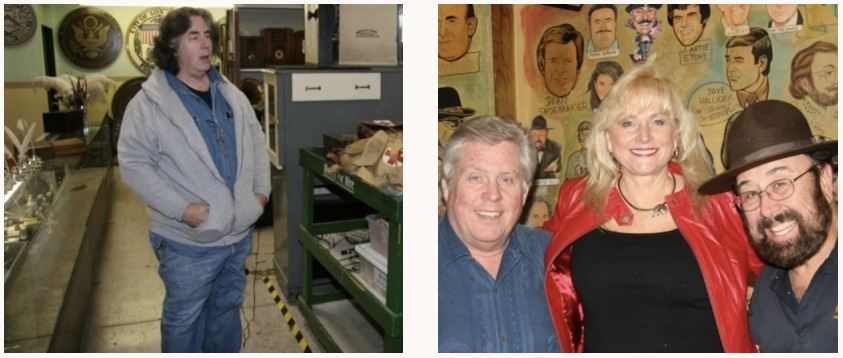
Above left is History For Hire owner, Jim Elyea. Chuck Pharis has helped Jim collect and reengineer cameras over the years and told me stories of how big the place was. Jim and I became friends last year when I helped him acquire 3 pristine Vinten Fulmar pedestals from Singapore. A collector there had short circuited their trip to the salvage yard and need help in finding them a new home. They have a new life in Hollywood now, and at this writing, the 3 peds are being used in the new Muppet Movie.
Before I lay out all the shots below with just a few comments on them, I’ve got to show you a very neat trick. I think Chuck Pharis taught Jim how to do this when they were building the three prop cameras used in American Dreams, which was a TV series that revolved around the early days of American Bandstand. You can see them below in a few pictures.
Since there are basically no working cameras from these early eras, they have to look like they are working, so all the old insides are taken out the real cameras, but saved for parts for collectors. That means little flat panel LCD screens for the view finder, and to make the illusion complete, not one, but four little lipstick cameras with different focal lengths, to imitate the different lenses on the turret that changes in the viewfinder when you rack the lenses to a new position.

Look carefully at the photo above. First, this is NOT a real TK30. All of Jim’s other cameras are real, but oddly, he has no real TK30s, so he had to make some, but that’s not why I’m showing you this.
See the small box under the lens turret on the bottom of the camera? It’s very non descript and looks like it could be one of the many modifications made to these cameras. Now…look below. The front of the box is open and shows the four small lipstick camera lenses that feed a picture to the LCD viewfinder screen and even to monitors in a control room if that is what’s called for. When the turret turns, there is a mechanism inside the hollow camera body that changes which lipstick lens is ”taking’ the shot. All of his cameras have this capability. Cool!
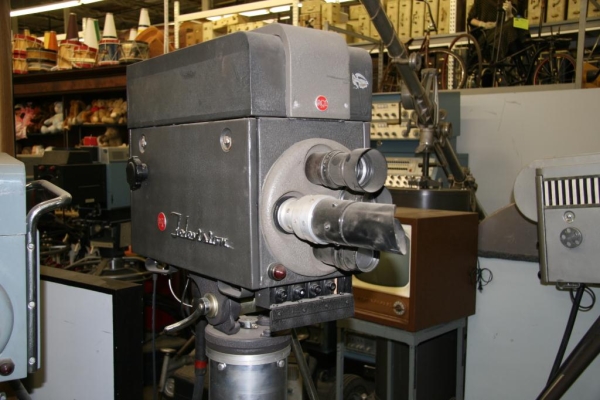
OK…here we go…enjoy!

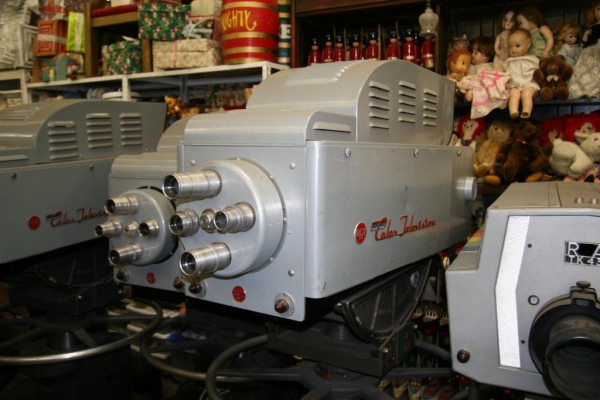
These 3 TK41s above are from CBS and have the lipstick cameras, too…all the cameras have them, even the TK42s below.
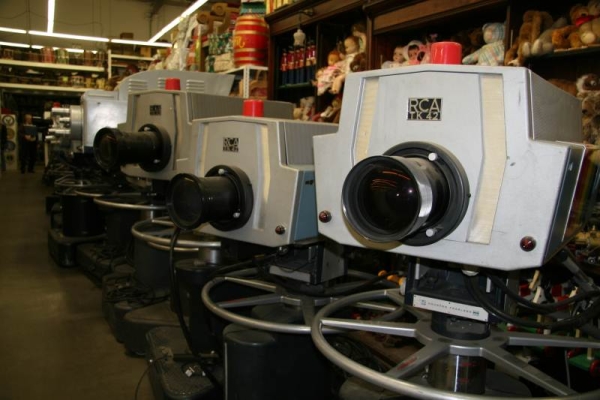

WOW! Camera Row!

Above, are the cameras built for “American Dream” , and again below behind a real TK10


Above, a real TK10 and below, a real good copy of a TK30 on a Panoram dolly


Believe it or not, this is a History for Hire built 1950s control room console, and it works.

Above, John’s friend Bob Snyder on Camera Row with TK60s, below, Norelcos!

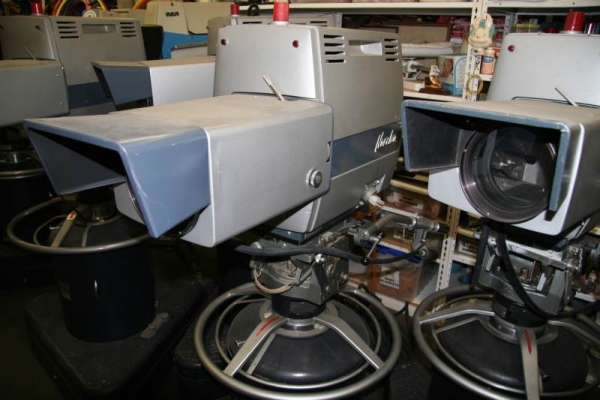
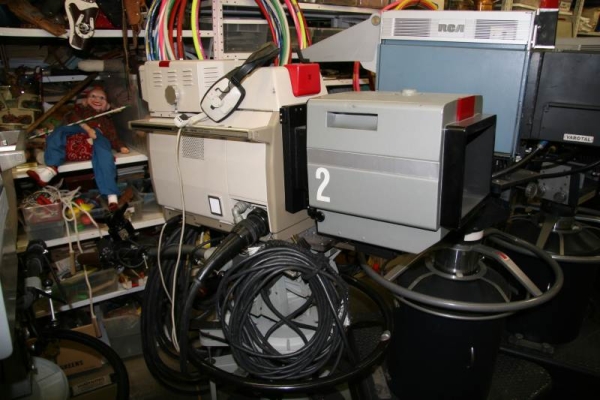
Above I see an Ikegami 323, TK44s and Howdy Doody? Below is one of their TK46s.








Below are Ampex mono tape recorders…a sight near and dear to my heart. This is what I used in my first days in radio in 1964. I’m still a great audio editor and these machines are one of the reasons why…it’s where I learned to splice and edit.

Surprise! MSNBC Primetime Convention Coverage Was From NYC!
On July 30, 2016
- TV History
Surprise! MSNBC Primetime Convention Coverage Was From NYC!
Who knew? I watched MSNBC a lot, and it was just like Brian Williams and Rachel Maddow were there in the hall. Actually, they were in MSNBC Studio 3A, in a the space usually occupied by the “Morning Joe” set.
The seamless blending was made possible by the large number of isolated camera feeds (via fiber optics) from the locations, that give the 3A control room the ability to operate as if the video sources were originating inside 30 Rock. With the giant LED wall screens behind them, using the iso camera from NBC News booth in the hall made it totally believable. Kudos! -Bobby Ellerbee


THANK YOU…AGAIN From Eyes Of A Generation!
On July 30, 2016
- TV History
THANK YOU…AGAIN From Eyes Of A Generation!
Yesterday, this page hit a new all-time-high weekly Post Reach of 420,277!
That is nearly double the number in Wednesday’s thank you post, for the new 225,061 threshold, achieved then. We’ve also had 361 page likes this week which gives us 9,077 members who have made “The Home of Television’s Living History”, their home too.
As I have said, I am not the one that makes it live…you do. I do my best to memorialize historic, or interesting moments in TV, but it is all of you who bring the life to it by adding your input, much of which is a rare first hand narrative from people that were there. Thanks also for the amazing images that you so generously share with us. Most of all, I thank you for your willingness to teach me, and all that come here, from the fullness of your experiences, which include every area of the broadcast industry. -Bobby Ellerbee
Page 19 of 136
« Previous
1
2
3
4
5
6
7
8
9
10
11
12
13
14
15
16
17
18
19
20
21
22
23
24
25
26
27
28
29
30
31
32
33
34
35
36
37
38
39
40
41
42
43
44
45
46
47
48
49
50
51
52
53
54
55
56
57
58
59
60
61
62
63
64
65
66
67
68
69
70
71
72
73
74
75
76
77
78
79
80
81
82
83
84
85
86
87
88
89
90
91
92
93
94
95
96
97
98
99
100
101
102
103
104
105
106
107
108
109
110
111
112
113
114
115
116
117
118
119
120
121
122
123
124
125
126
127
128
129
130
131
132
133
134
135
136
Next »